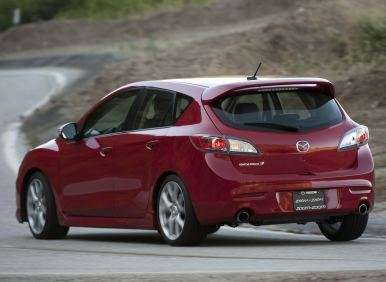Recent Articles
Popular Makes
Body Types
Mazda Mazdaspeed3 Used Car Buyer’s Guide
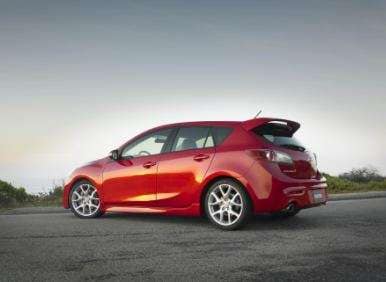
The smoking hot little car with a very long name; Mazda’s Mazdaspeed3 actually started life with an even longer name: Mazda Mazdaspeed3 Mazda 3. When the second generation of the car was introduced for model year 2010, Mazda’s marketing team wisely decided to drop the triple redundancy, thus rendering the car’s name a bit more wieldable.
(We’re hoping at some point they’ll realize they don’t need to say Mazda twice and simply call the car the Mazdaspeed3—and be done with it.)
As suggested by its nomenclature, the Mazdaspeed3 is based on the Mazda3, a car you’ll find more information about here. As you may have read, we’re quite fond of the Mazda3 and we also consider it a bargain at its price. Nicely turned out, with a handsome appearance and a strong feature set, the Mazda3 is more like a compact entry-level luxury car than the economical runabout its price would lead one to expect.
Thus, as the basic platform for the Mazdaspeed3, the Mazda3 is well suited Its steering is highly responsive and its suspension set up is endowed with both exciting handling and a comfortable ride. The only thing needed to add to that formula to get a serious performance car was an engine capable of moving the Mazda3 with exceptional alacrity, an even more agile suspension system, and brakes to match.
Which, is exactly what the Mazdaspeed3 engineering team proceeded to do.
The in-house racing and street car tuning division of Mazda, Mazdaspeed has fielded a Le Mans-winning entry (something no other Japanese manufacturer can claim) in addition to offering tuned versions of the Protégé, Mazda6, and the MX-5 (Miata).
The group delivered the Mazdaspeed3 in 2007 as the most powerful vehicle in its class.
To date, Mazda has marketed two generations of the Mazdaspeed3.
Mazda Mazdaspeed3 Used Car Buyer’s Guide: 2007 - 2009
Available only in the hatchback configuration of the Mazda3, the Mazdaspeed3—from the get-go—was intended to be an all-out high performance “tuner” version of the Mazda3. Similar in concept to Subaru’s effort with the WRX and Mitsubishi’s effort with the Lancer Evolution, the Mazdaspeed3 was sent to market with a 263-horsepower 2.3-liter double overhead cam 16-valve turbocharged inline four-cylinder engine with variable valve timing. The powerplant was also capable of generating 280 ft-lbs of torque. The Mazdaspeed3 used a six-speed manual transmission, a lowered sport suspension system, and performance-oriented tires mounted on 18-inch wheels.
The all-independent suspension system consisted of a MacPherson strut front configuration and a multi-link rear configuration. It also used front and rear stabilizer bars. Additional cross-members within the chassis frame and body stiffened the vehicle to improve handling and control under heavy braking and acceleration, as well as limiting the likelihood of torsional flex of the monocoque body structure.
Power was routed to the front wheels through a limited slip differential. An electronic torque management system was employed to reduce torque steer in first gear. For those of you unfamiliar with the concept, when that much torque is routed to the front wheels, it has a tendency to try to steer the car. Some manufacturers counter this by using uneven length drive shafts; Mazda chose to electronically reduce the engine’s torque potential in first gear or when the steering wheel was turned too far, in order to prevent the engine’s output from determining the car’s direction of travel.
To give the Mazdaspeed3 the stop to match its go, the engineering team further specified 12.6-inch ventilated front disc brakes and 12.02-inch solid disc brakes for the rear. The standard Mazda3 uses 10.9-inch brakes in the front and 10.4-inch brakes in the rear.
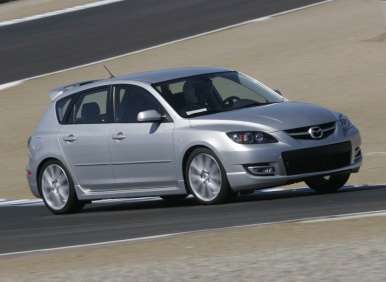
Mazda Mazdaspeed3 Used Car Buyer’s Guide: 2007
The 2007 Mazda MAZDASPEED3 Mazda 3 was offered in two states of trim; “Sport” and “Grand Touring”. The sport model featured a rear spoiler, 18-inch alloy wheels, a steel spare wheel, an inside mounted temporary spare tire, variable intermittent wipers, a rear window defogger, and an intermittent rear windshield wiper.
Height adjustable front sports seats featured additional bolstering to hold occupants in place when the car was cornering briskly, and they were upholstered in premium cloth. The driver’s seat featured a manually adjustable lumbar support. The rear seats were configured to split fold and featured a folding center armrest. A set of ventilation ducts conducted air to the rear passengers.
The Mazda’s power door locks were capable of being operated remotely, its outside mirrors were power adjustable, and all four of its side windows were power operated— with a one-touch function for the driver’s window.
The 2007 Mazda Mazdaspeed3 Mazda 3 Sport also came equipped with cruise control, a front console with storage, a set of front and rear cup holders, a pair of front door pockets, and storage in both front seatbacks. The tilt and telescoping steering wheel controlled an electric speed proportional power steering system and also featured both audio and cruise controls
Its climate control system included interior air filtration, there was a cargo area light, front reading lights, leather trim for the shift knob and steering wheel, dual illuminated vanity mirrors, front and rear floor mats, an exterior temperature display, and a clock.
The 2007 Mazdaspeed3’s audio system consisted of an AM/FM single-disc CD player with speed sensitive volume control and an auxiliary input jack for portable audio devices. The head unit’s output was fed to six speakers.
The complement of safety features included ABS for all four wheels, stability control, traction control, front and rear head airbags, dual front side-mounted airbags, child seat anchors, emergency braking assist, rear door child safety locks, and engine immobilizer, and front fog lights. A rear center three-point seatbelt, as well as front seatbelt pre-tensioners accompanied a passenger airbag occupant sensing deactivation system. The Mazdaspeed3 also featured passenger and driver head restraint whiplash protection systems—in addition to tire pressure monitoring.
The Grand Touring Mazdaspeed3 model used automatic xenon HID headlights, LED tail lights, rain sensing variable intermittent wipers, leather and cloth upholstery, and a Bose audio system featuring seven speakers, an in-dash six-disc CD player, a subwoofer, and a 222-watt amplifier. A navigation system with satellite radio was optional for the Grand Touring Mazdaspeed3.
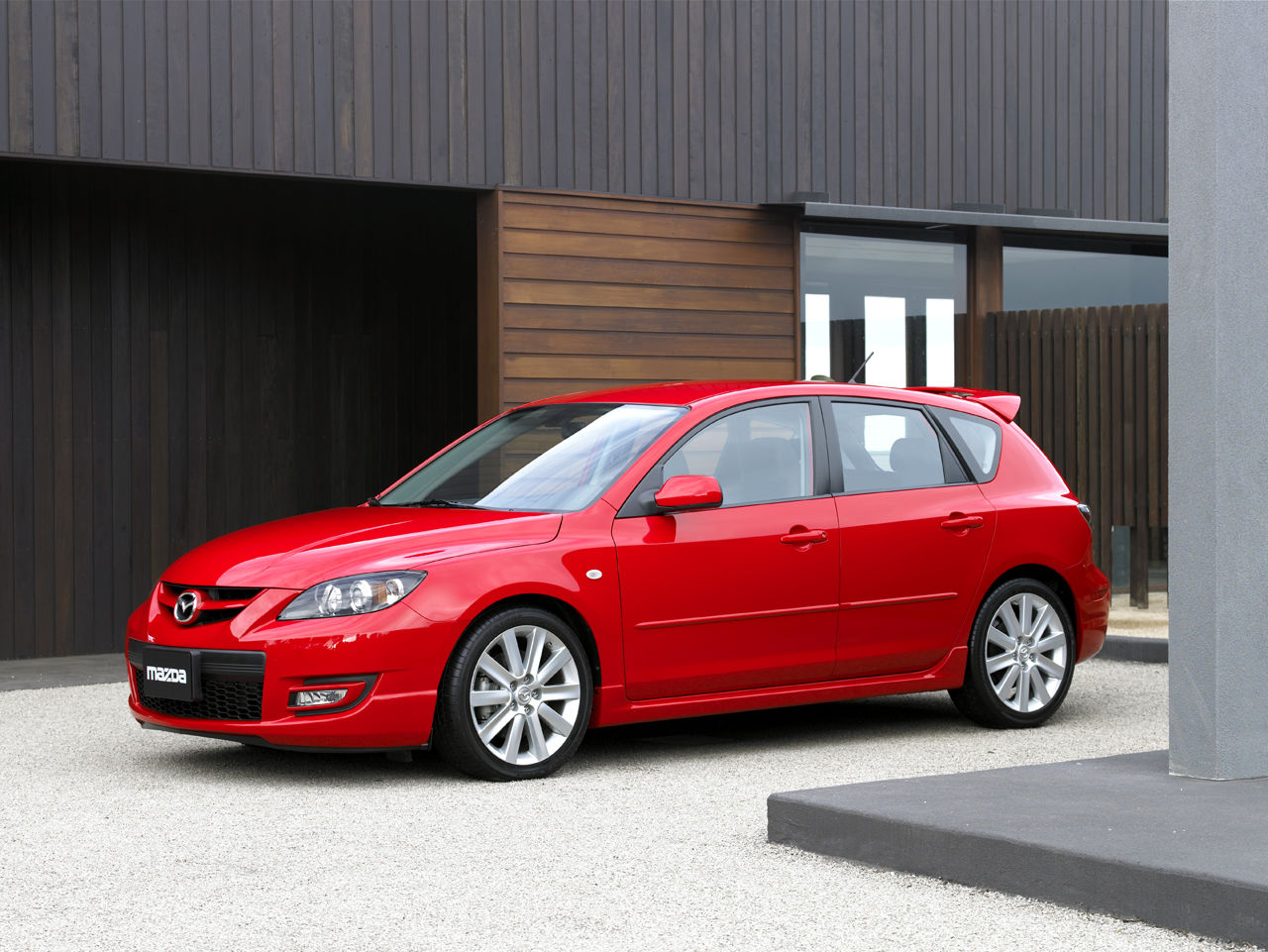
Mazda Mazdaspeed3 Used Car Buyer’s Guide: 2008 / 2009
The Mazda Mazdaspeed3 Mazda 3 was unchanged for model year 2008.
The Mazda Mazdaspeed3 Mazda 3 was unchanged for model year 2009.
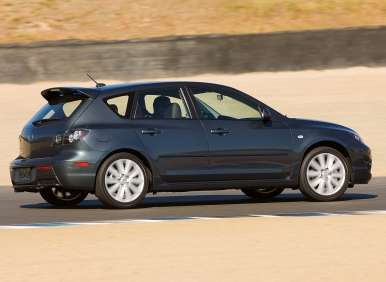
Mazda Mazdaspeed3 Used Car Buyer’s Guide: 2010 – Current (2012)
The 2010 redesign of the Mazda3 also resulted in a new 2010 Mazda MAZDASPEED3. While output of the engine remained the same at 263 horsepower and 280 foot-pounds of torque; the engine control unit was tweaked to adjust the power curve, the gear ratios in the transmission were revised, and a fully functional food scoop was installed to run air to the top mounted intercooler to increase the density of the intake charge.
Other than that, for the second generation of the Mazdaspeed3, Mazda’s engineers kept the mechanical aspects of the car largely the same; preserving the driving characteristics most appreciated about the fire-breathing compact while infusing it with better fuel economy. Given the 2010 Mazdaspeed3 experienced a bit of a weight gain over the 2009 model, the engine tweaks also enabled performance to remain on par with the previous version of the car.
All new exterior and interior styling, along with added equipment offerings made the 2010 Mazdaspeed3 an even more enticing proposition. Incorporating more high-strength steel in the model’s construction and revising the already agile suspension system improved the Mazdaspped3’s handling while preserving its comfortable ride. The revised styling improved aerodynamics, which reduced wind noise and enabled better gas mileage.
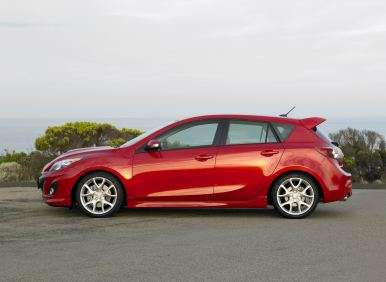
Mazda Mazdaspeed3 Used Car Buyer’s Guide: 2010
For the 2010 model year, the Mazda Mazdaspeed3 hatchback was offered in but one state of trim: “Sport”. The Grand Touring model was dropped. However, many of its features were incorporated into the sport model as standard equipment.
That said, the 2010 Mazda Mazdaspeed 3 featured a rear spoiler, 18-inch alloy wheels with performance tires, and inside mounted temporary spare tire, variable intermittent windshield wipers, a rear defogger, and an intermittent wiper for the rear window. Just as before, the four-wheel independent suspension system was comprised of a MacPherson strut front configuration and a Multilink rear configuration.
The front sport seats featured additional bolstering just as before to hold occupants more comfortably when the car was cornering. The interior was upholstered in black leather with red cloth inserts, the rear seatback was configured to split fold, and it contained a folding armrest with storage. There were also ventilation ducts in the rear passenger compartment.
The 2010 Mazdaspeed 3 offered remote power door locks, power exterior mirrors, 4 power windows with a one-touch feature for the driver’s window. The Mazda came with cruise control, a front console with storage, front and rear cup holders, door pockets in the front and rear, storage in both front seat backs, and a pair of 12 V power outlets. The tilt and telescoping steering wheel used speed proportional power steering, and contained audio and cruise controls on the wheel.
The climate control system was a dual zone configuration for the driver and passenger and featured interior air filtration. There was a cargo area light, front reading lights, and a pair of dual illuminating vanity mirrors. The center console and doors featured simulated alloy trim, the shift knob and steering wheel were trimmed in leather, the exterior mirror housings featured turn signal repeaters, and there were front and rear floor mats.
The basic audio system was an AM/FM single-disc CD player with CD MP3 playback capability, it featured adjustable speed sensitive volume control and an auxiliary input port for portable audio devices. The Mazdaspeed 3 was also prewired for cellular phones and incorporated Bluetooth data streaming.
Optional features included an auto-dimming rearview mirror with an integrated compass, or an auto-dimming rearview mirror with an integrated compass and Homelink. Satellite radio was an option with a six-month free subscription, as were a set of all weather floor mats and a cargo net. Keyless entry/ignition, Bose surround audio, and a navigation system were available as part of the optional Tech package.
Safety features included stability control, traction control, four-wheel ABS, front head airbags, dual front side-mounted airbags, child seat anchors, and emergency braking assist. The front disc brakes were ventilated, the rear disc brakes were solid.
The 2010 Mazdaspeed3 also incorporated rear door child safety locks, an engine immobilizer, front fog lights, a passenger airbag occupant sensing deactivation system, a rear center three-point seatbelt, and front seatbelt pre-tensioners. The high-performance compact was also equipped with electronic brake force distribution, passenger and driver head restraint whiplash protection systems, and tire pressure monitoring.
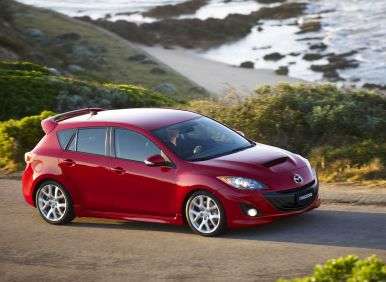
Mazda Mazdaspeed3 Used Car Buyer’s Guide: 2011
For 2011, Mazda’s Mazdaspeed3 optional Tech package was adjusted to incorporate keyless ignition/entry, rain-sensing intermittent wipers, automatic/adaptive bi-xenon headlights, rear LED taillights, an integrated compact navigation system, and a 10-speaker Bose surround-sound stereo with an integrated six-disc CD changer.
Satellite radio and an auto-dimming rearview mirror were offered as stand-alone options.

Mazda Mazdaspeed3 Used Car Buyer’s Guide: 2012
For 2012, the “Sport” designation was dropped. Instead, the Mazdaspeed3 is now available in but one in trim level, known as the 2012 Mazda MAZDASPEED3 “Touring”.
Standard equipment includes 18-inch wheels, a limited-slip differential, full power accessories, keyless entry, cruise control, a dual-zone automatic climate control system, a height-adjustable driver seat with manually adjustable lumbar support, a tilt-and-telescoping leather-wrapped steering wheel with audio and cruise controls, an adjustable front center armrest, a trip computer, Bluetooth phone and audio connectivity, and a 10-speaker Bose surround-sound audio system with a CD player, an auxiliary input jack for portable audio players and.
The optional Mazdaspeed3 Technology package laces the car with automatic and adaptive bi-xenon HID headlights, a blind-spot monitoring system, rain sensing intermittent automatic wipers, keyless ignition/entry, satellite radio, which is also available separately, and a navigation system with a compact display screen and steering wheel controls.
Dealer-installed accessories include an iPod interface and a six-disc CD changer.
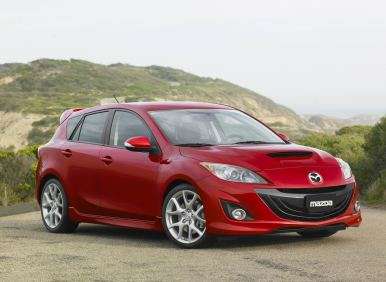
Mazda Mazdaspeed3 Used Car Buyer’s Guide: Summary
One of the most affordable high-performance cars on the market, the Mazda Mazdaspeed3 represents an outstanding bargain on the preowned market.
You need to be careful when shopping though; because of the car’s performance potential the likelihood of previous abuse is high. Also, because were talking about a high-performance model, the price of insurance will be higher as well.
It's a good idea to check with several insurance companies to find out how much the premium will be before buying the car. The last thing you want to do is get a great deal on a really clean Mazdaspeed 3, only to discover you can't afford the insurance. So get the insurance quote first.
Again, many previous owners will have exploited Mazdaspeed 3’s performance potential quite liberally. For this reason, you’ll want to be particularly careful about making sure you have any car you're seriously interested in subjected to a very thorough pre-purchase inspection by a trusted, professional, independent mechanic—one very familiar with Mazda’s products.
Mazda has also issued few recalls for this model, so you'll want to run an Internet search for “Mazda Mazdaspeed 3 recalls” to learn which updates apply to your particular car.
While you're on the net, take the time to order a vehicle history report against the VIN of any car you are seriously considering, to make sure its title is clean, and its maintenance history is well documented.
